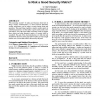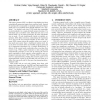78
Voted
CCS
2006
ACM
15 years 4 months ago
2006
ACM
Why measuring security? To make good decisions about how to design security countermeasures, to choose between alternative security architectures, and to improve security during d...
104
Voted
CCS
2006
ACM
15 years 4 months ago
2006
ACM
In-network aggregation is an essential primitive for performing queries on sensor network data. However, most aggregation algorithms assume that all intermediate nodes are trusted...
97
Voted
CCS
2006
ACM
15 years 4 months ago
2006
ACM
We extend the definitional work of Dwork, Naor and Sahai from deniable authentication to deniable key-exchange protocols. We then use these definitions to prove the deniability fe...
110
click to vote
CCS
2006
ACM
15 years 4 months ago
2006
ACM
A multi-signature scheme enables a group of signers to produce a compact, joint signature on a common document, and has many potential uses. However, existing schemes impose key s...
65
Voted
CCS
2006
ACM
15 years 4 months ago
2006
ACM
CCS
2006
ACM
15 years 4 months ago
2006
ACM
116
click to vote
CCS
2006
ACM
15 years 4 months ago
2006
ACM
Attack graphs are important tools for analyzing security vulnerabilities in enterprise networks. Previous work on attack graphs has not provided an account of the scalability of t...
130
Voted
CCS
2006
ACM
15 years 4 months ago
2006
ACM
This paper presents EXE, an effective bug-finding tool that automatically generates inputs that crash real code. Instead of running code on manually or randomly constructed input,...
106
Voted
CCS
2006
ACM
15 years 4 months ago
2006
ACM
A time-bound hierarchical key assignment scheme is a method to assign time-dependent encryption keys to a set of classes in a partially ordered hierarchy, in such a way that each ...
108
Voted
CCS
2006
ACM
15 years 4 months ago
2006
ACM
Accurate and synchronized time is crucial in many sensor network applications due to the need for consistent distributed sensing and coordination. In hostile environments where an...


